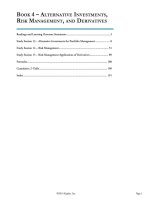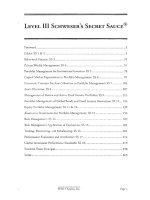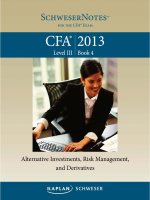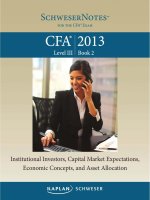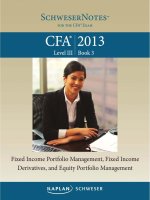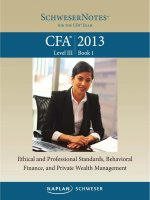2019 CFA level 3 qbank r 24 25 yield curve str credit str answers
Bạn đang xem bản rút gọn của tài liệu. Xem và tải ngay bản đầy đủ của tài liệu tại đây (652.92 KB, 13 trang )
10/12/2018
Learning Management System
Question #1 of 19
Je Nordby is a currency trader at a regional investment bank in Baltimore, MD. His research
department is anticipating a stable yield curve environment for the remainder of the year and
Japan's central bank will continue to depress the value of the Yen versus the Dollar for the near
future. As a result of his team's forecast, Je decides to enter into a Yen carry trade with the
U.S. dollar.
The position that Je used to execute his strategy is most likely:
.in
A) Borrowing at the lower Yen rate, converting the Yen to dollars and purchasing U.S.
Treasuries.
en
tre
B) Borrowing at the U.S. short-term rate, converting the dollar to Yen and purchasing
Yen Gov’t securities.
C) Borrowing at the higher dollar rate, converting the dollars to Yen and purchasing
bo
ok
c
Yen Gov’t securities.
Explanation
.o
m
Prior to the nancial crisis, the Yen-Dollar trade was a very popular carry trade. However,
since the crisis, most of the developed currencies short- term rates have been very low, which
eliminated the carry trade advantage associated with developed market currencies. However,
it is has become common to borrow in developed currencies, convert the developed currency
into under-developed currencies and purchase under-developed government securities to
take advantage of the higher interest rates in developing currencies.
w
w
(Study Session 12, Module 24.3, LOS 24.c)
Related Material
w
SchweserNotes - Book 3
Question #2 of 19
As a result of the continued global low interest since the nancial crisis of 2008, investors have
been investing in larger amounts of emerging market corporate bonds to nd increased yields.
However, investing in emerging market corporate bonds is very di erent than investing in
developed market corporate bonds.
The following statement correctly identi es these general di erences:
/>
1/13
10/12/2018
Learning Management System
A) Emerging market bonds have an increased concentration in commodities and
banking compared to developed market bonds.
B) Since the most recent nancial crisis, the developed bond market is overcontrated
in government issued bonds as compared to emerging market capital markets as
i
f b d
C) Developed market bonds tend to have lower average credit quality compared to
emerging market bonds.
Explanation
(Study Session 12, Module 25.3, LOS 25.g)
Related Material
Question #3 of 19
bo
ok
c
SchweserNotes - Book 3
en
tre
.in
We have seen unprecedented growth in emerging market bonds as investors continue to
search for higher yield. Compared to developed market bonds, emerging market bonds: tend
to be overly concentrated in commodities and banking, are concentrated by emerging market
government issued debt and tend to have lower credit quality compared to developed
market bonds.
m
Tara Timura is a new xed income analyst for a U.S. bond fund. She has only been at the rm
for a few weeks and has asked to assist the lead portfolio manager in modeling the rm's yield
.o
curve quarterly forecast.
w
w
Modeling the yield curve for xed income professionals is complicated because:
A) Observations are normally consistent with the neighboring values which helps to
w
reduce the complexity associated with yield curve modeling.
B) Gaps in maturities are common and must be interpolated, increasing model
complexity.
C) Luckily, di erences in accounting rarely impact bond prices, so modeling
complexity is reduced.
Explanation
The complexity of modeling the yield curve is increased because maturity gaps must be
interpolated. Also, observations are not always consistent with neighboring values and
di erences in accounting rules can impact bond prices dramatically.
(Study Session 12, Module 24.2, LOS 24.a)
/>
2/13
10/12/2018
Learning Management System
Related Material
SchweserNotes - Book 3
Question #4 of 19
Global portfolio managers can often hedge emerging market currency risk by all of the
following, except:
A) selling currency forwards.
.in
B) selling currency futures.
Explanation
en
tre
C) swapping the foreign currency for domestic currency of the investor.
Futures market contracts don't exist for most emerging market currencies so most global
portfolio managers use forwards and swaps to hedge currency exposure.
bo
ok
c
(Study Session 12, Module 25.3, LOS 25.g)
Related Material
m
SchweserNotes - Book 3
.o
Question #5 of 19
w
w
Derek Main is a recent college graduate and has been hired as a full-time junior analyst for
Falcon Financial, a rm that specializes in providing xed income investment advice to local
w
pensions. Main has been assigned to analyze a newly issued putable bond.
Main calculates various credit spread measures to begin his analysis.
The calculated spread measures are as follows:
G – Spread 322
I – Spread
325
Z – Spread 334
Main notices that he forgot to calculate an OAS measure, would the OAS be similar to, lower
than, or higher than the Z spread measure:
/>
3/13
10/12/2018
Learning Management System
A) OAS would be lower than the Z spread.
B) OAS would be higher than the Z Spread.
C) OAS would be similar to the Z spread.
Explanation
OAS would be higher than the Z-spread because the bond is putable and has favorable
redemption features in a rising interest rate environment for the investor.
(Study Session 12, Module 25.1, LOS 25.b)
Related Material
en
tre
.in
SchweserNotes - Book 3
Question #6 of 19
Laura Timura is the chief risk manager for Quanta Financial, a U.K. based consulting rm that
bo
ok
c
specializes in risk management strategies for xed income investors. A large endowment
recently received a signi cant holding in a publicly traded gold mining stock and has hired
Quanta to help them hedge this position until they can sell the shares in 5 years.
Quanta has recommended a hedging strategy to minimize tail risk that most likely includes:
m
A) selling put options on gold futures contracts.
.o
B) purchasing calls on gold futures.
w
w
C) buying credit spread options on the bonds of gold miners they nd least attractively
valued.
w
Explanation
Quanta most likely would recommend buying put options on gold futures or credit default
swaps (CDS) to execute a tail risk hedge.
(Study Session 12, Module 25.3, LOS 25.f)
Related Material
SchweserNotes - Book 3
Question #7 of 19
/>
4/13
10/12/2018
Learning Management System
David Stephen is a Fixed Income Strategist for a large hedge fund. After extensive analysis and
research, Stephen is predicting an extremely stable yield curve environment for the next few
quarters that will remain upward sloping. Assuming Stephen's prediction is correct, what active
management strategy would Stephen least likely pursue?
A) Riding the yield curve.
B) The carry trade.
C) Buying convexity by shifting to a barbell strategy.
Explanation
Related Material
Question #8 of 19
bo
ok
c
SchweserNotes - Book 3
en
tre
(Study Session 12, Module 24.3, LOS 24.c)
.in
Assuming Stephen's prediction of a stable yield curve environment, David would need to sell
convexity, he would not buy it. Convexity can be decreased by buying MBS and callable bonds
to increase yield.
m
If a new government bond is issued with a negative coupon rate due to low rates of interest,
.o
the duration of the new bond will:
A) not be a ected by its negative coupon rate.
w
w
B) be shorter than its maturity.
w
C) be longer than its maturity.
Explanation
If bonds are issued with negative coupon rates, the duration of the bonds will be longer than
the maturity.
(Study Session 12, Module 24.2, LOS 24.a)
Related Material
SchweserNotes - Book 3
Question #9 of 19
/>
5/13
10/12/2018
Learning Management System
Bill Mclaughlin is a xed income consultant based in the US. Last year, he forecasted very little
changes in the yield curve for the next 14 months with a normal yield curve. Mclaughlin
concentrated his portfolio on 10-Year US Treasury Bonds that had a 2.25% coupon and he
purchased his holdings at an average price of 100.38. Mclaughlin expected to sell the bonds in
one year at 101.92. Mclaughlin selected the 10-year maturities because they were the steepest
part of the yield curve that he could purchase since he was constrained to a 10-year maturity
from the IPS.
At the start of last year, the expected rolling yield on the portfolio was closest to:
A) 2.24%.
.in
B) 1.05%.
Explanation
Rolling Yield = Yield Income + Rolldown Return
en
tre
C) 3.74%.
bo
ok
c
Yield Income = Annual coupon payment / current bond price = $2.25 / $100.38 = 2.24%
Rolldown return = (Bond Price End – Bond Price Begin) / Bond Price Begin = $101.92 –
$100.38 / $100.38 = 1.5%
Rolling Yield = 2.24% + 1.5% = 3.74%
Related Material
w
w
.o
SchweserNotes - Book 3
m
(Study Session 12, Module 24.8, LOS 24.i)
w
Question #10 of 19
Valerie is the investment strategist for a local nancial advisor and is thinking of making tactical
changes to her xed income investment model. Valerie decides to match the primary risk factor
of her target benchmark but also take advantage of an expected increase in yield curvature.
A) Create a bullet portfolio that is focused on the middle of the yield curve.
B) Short the barbell and long intermediate-term bonds.
C) Create a butter y portfolio.
Explanation
/>
6/13
10/12/2018
Learning Management System
When the yield curve curvature is expected to increase Valerie should use a barbell strategy
or a butter y portfolio which is going short intermediate-term bonds and long the barbell.
(Study Session 12, Module 24.7, LOS 24.h)
Related Material
SchweserNotes - Book 3
Question #11 of 19
Gerhard Thompson is a xed income PM for a large investment consulting rm based in the US
.in
and has spent the last few weeks analyzing the bond market, speci cally focusing on yield curve
en
tre
forecasting. Thompson's forecast is for the yield curve to remain relatively stable for the rst
half of the year. The investment strategy that Thompson is most likely to follow over the next
few months, assuming his forecast is correct, is:
A) replacing callable bonds with straight bullet bonds.
bo
ok
c
B) selling options indirectly by purchasing Mortgage Backed Securities (MBS).
C) buying options indirectly by selling MBS.
Explanation
m
To reduce convexity, Thompson will purchase MBS. MBS have an embedded call option that
can be exercised by the home buyer.
.o
Selling MBS securities would increase convexity, not reduce it.
w
w
Replacing callable bonds with straight bullet bonds would also increase convexity.
(Study Session 12, Module 24.5, LOS 24.d)
w
Related Material
SchweserNotes - Book 3
Question #12 of 19
/>
7/13
10/12/2018
Learning Management System
Randolph David has just won a Request For Proposal to manage a portion of a large
multinational corporation's xed income portfolio that totals $25 million. David is preparing to
implement the portfolio and he is now wondering if he should make a temporary tactical
adjustment to take advantage of an expected steepening of the yield curve with a curvature
decrease.
David forecasts partial durations of his original portfolio and his proposed portfolio (see PVBP
below).
Key Rate PVBPs 1 year 2 year 3 year 5 year 10 year
.0049
.0061
.0135
.0136
Tactical Portfolio 0
.0087
.0030
.0065
.0146
.in
Original Portfolio 0
a curvature decrease is:
A) David should select the original portfolio.
en
tre
The most optimal portfolio assuming David is correct and the yield curve steepens and also has
bo
ok
c
B) David should invest 50% in the original portfolio and 50% in the tactical portfolio.
C) David should select the tactical portfolio.
Explanation
.o
m
David should execute his original portfolio and not make the tactical changes from his
forecasts since the originally proposed portfolio has less partial duration at the ends of the
projected key rate durations and increased partial duration in the 3-year and 5-year
maturities compared to the tactical portfolio.
w
w
(Study Session 12, Module 24.7, LOS 24.f)
Related Material
w
SchweserNotes - Book 3
Question #13 of 19
A credit investor has been conducting extensive research on incorporating ESG considerations
into his security selection in the technology sector. The investor has created a custom
benchmark consisting of corporate technology bonds and his goal is to outperform the
benchmark.
Which credit investment strategy is most appropriate for the credit investor to follow?
/>
8/13
10/12/2018
Learning Management System
A) Top-down approach.
B) Bottom-up approach.
C) Multi-factor approach that focuses on predicting economic cycles.
Explanation
A bottom-up approach is more appropriate for this investor. The investor has conducted
extensive research, including ESG factors into their analysis regarding the technology sector.
(Study Session 12, Module 25.2, LOS 25.d)
Related Material
en
tre
.in
SchweserNotes - Book 3
Question #14 of 19
Fixed Income Portfolio managers can use butter y spreads to take advantage of changes in
bo
ok
c
curvature of the yield curve. A butter y spread trade that will pro t from a relative decrease in
intermediate rates is:
A) long the 2- and 30-Year yield, short the 10-Year yield
B) short the 2- and 10-Year yield, long the 30-Year yield
.o
Explanation
m
C) short the 2- and 30-Year yield, long the 10-Year yield
w
w
w
A butter y spread measures the di erential in intermediate versus longer and shorter rates.
A butter y trade is long (or short) intermediate (bullet) duration and short (or long) an
equivalent weighted average duration combination of shorter and longer duration (barbell)
bonds. With an expected relative decline in intermediate rates you will want a long position in
the intermediate (in this case 10-year) bond to capture its relative price appreciation. One of
the other choices does not meet the de nition of long and short a bullet and barbell. The
other does meet the de nition but shorting the intermediate position pro ts if intermediate
rates increase.
(Study Session 12, Module 24.2, LOS 24.a)
Related Material
SchweserNotes - Book 3
Question #15 of 19
/>
9/13
10/12/2018
Learning Management System
Sunil Ranieel is an investment-grade xed income investment strategist for a large pension
fund based in the UK. Ranieel was at a recent luncheon and was describing his investment
process to some local college students at his lunch table. Ranieel's investment process will
primarily be focused on:
A) collateral valuation.
B) interest rates.
C) debt covenants.
Explanation
Related Material
Question #16 of 19
bo
ok
c
SchweserNotes - Book 3
en
tre
(Study Session 12, Module 25.1, LOS 25.a)
.in
An investment grade portfolio manager would focus on interest rates and interest rate risks
and would not emphasize debt covenants and collateral valuation because investment grade
bonds have high credit evaluation metrics.
m
There are potential bene ts for a corporate bond portfolio manager to include CDOs in their
.o
portfolio except:
A) relative value opportunities.
w
w
B) diversi cation.
w
C) leverage opportunities.
Explanation
The collateral for a CDO is frequently corporate bonds, so there is little diversi cation
bene ts for a corporate bond portfolio manager to include CDOs in their portfolio.
(Study Session 12, Module 25.4, LOS 25.h)
Related Material
SchweserNotes - Book 3
Question #17 of 19
/>
10/13
10/12/2018
Learning Management System
Bid-ask spreads have historically been used to assess liquidity in xed income markets.
However, this indicator has proven to be less reliable primarily because:
A) of increased assets under management in Fixed-Income ETFs.
B) of reduced spread sensitivity to fund out ows.
C) bond dealers and brokers generally hold much less inventory than in the past
because of regulatory and capital constraints.
Explanation
As a result of regulatory and capital requirements, bond dealers/brokers now hold less
inventory that traditionally provided market liquidity.
.in
(Study Session 12, Module 25.3, LOS 25.e)
en
tre
Related Material
Question #18 of 19
bo
ok
c
SchweserNotes - Book 3
Susan Walrad has currently been hired as a summer intern for a prestigious investment bank
and wants to impress her boss. Susan learns that her boss, Ted, is currently preparing for an
m
upcoming meeting with one of their top clients to discuss the performance of bullet and barbell
investment strategies under di erent yield curve scenarios. Susan talks with Ted and learns
.o
that Ted is going to recommend an investment strategy that works best in an increased interest
w
w
rate volatility environment.
The strategy that Ted would most likely select:
w
A) a barbell strategy consisting of buying 5-year and 20-year Treasury government
bonds.
B) a carry trade.
C) a bullet strategy that will only purchase a 10-Year Treasury government bond.
Explanation
/>
11/13
10/12/2018
Learning Management System
A barbell strategy will generally outperform in an increased interest rate volatility
environment and a bullet strategy will generally underperform in this environment (see table
below).
Relative Performance of Bullets and Barbells under Di erent Yield Curve Scenarios
Yield Curve Scenario
Barbell
Bullet
Level change
Parallel shift
Outperforms
Underperforms
Slope change
Flattening
Outperforms
Underperforms
Steepening
Underperforms Outperforms
Less curvature
Underperforms Outperforms
More curvature
Outperforms
Decreased rate
volatility
Underperforms Outperforms
Increased rate
volatility
Outperforms
Underperforms
bo
ok
c
(Study Session 12, Module 24.6, LOS 24.e)
.in
Rate volatility
change
Underperforms
en
tre
Curvature change
Related Material
m
SchweserNotes - Book 3
.o
Question #19 of 19
w
w
A bond portfolio manager using the bottom-up approach to security selection would most likely
begin their analysis by focusing on:
w
A) bonds that have comparable credit risk.
B) average credit spreads.
C) macro factors that drive interest rates.
Explanation
Bottom-up credit analysis is most appropriate for analyzing securities that have similar credit
risk.
(Study Session 12, Module 25.2, LOS 25.c)
Related Material
SchweserNotes - Book 3
/>
12/13
Learning Management System
w
w
w
.o
m
bo
ok
c
en
tre
.in
10/12/2018
/>
13/13
